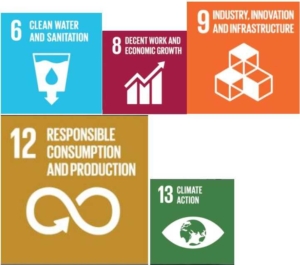Strategic Fields, Environment and Resources – AT&S Explains
We started with a brief introduction to sustainability strategies as a whole, then an overview over the four strategic fields of action that make up the AT&S sustainability strategy. Now, it’s time to roll up our proverbial sleeves and dig in deep. Today’s topic, as mentioned in our last sustainability post, is our first strategic field of action: Environment & Resources. You may be thinking that this strategic field of action is pretty self-explanatory. However, as is often the case here at AT&S – there is more to it than initially meets the eye.
Environment & Resources beinhaltet fünf der Sustainable Development Goals (SDGs) der Vereinten Nationen und fokussiert auf “effiziente Produktionstechnologien”.

As you already know, each of these goals is relevant to AT&S in a different manner. Goal 9: Industry, Innovation and Infrastructure, for example, is reflected in the aspects of the AT&S energy strategy, which aims to have at least 80% of the Group’s energy requirements to be supplied by renewable energy sources (including large hydropower plants) by 2025. We at AT&S are confident that this can only be achieved through strong partnerships, higher resource efficiency and eco-friendly technologies. Of course, this also strongly ties in with both SDG 17 (Partnership for the Goals) and SDG 13 (Climate Action).
AT&S contributes to Goal 6: Clean Water and Sanitation by committing to the prevention of water pollution as well as the release of chemicals and hazardous substances. The production of printed circuit boards and IC substrates requires a large number of wet-chemical and water-intensive processes. In production, deionized and ultra-pure water is needed for process water. Furthermore, due to exothermal chemical production processes, water is also used to cool machinery. This of course means we produce a lot of wastewater. In addition to an external feed line to the wastewater treatment plant, the wastewater is treated via a chemical-physical wastewater plant or passed through clarification and biofilter systems and cooling towers.
Reducing the quantity of waste, particularly hazardous waste is another central element of our sustainability strategy and aids in our contribution to Goal 12: Responsible Consumption and Production. Therefore, AT&S initiated a copper recycling project.
With 4,066 tonnes of copper accounting for the largest share of production materials used, and with it being an indispensable raw material for the production of printed circuit boards, such a project is vital for the reduction of our waste.
Copper-containing material flows are incurred in the production of the conductive pattern, and a large part of them is fed into the company’s internal wastewater treatment plants. Before disposing of the copper-containing sludge that is created in this process, a wide variety of chemicals is now used to treat the waste. By recovering copper-containing acids from production processes, raw material efficiency is increased, which leads to a reduction of the chemicals used and the waste produced. Thus, we are able to create a more circular use of both copper and water as materials in the plants.
“Sustainability is often associated with an increasing scarcity of resources,” explains Theresa Gruber, Specialist Corporate Sustainability at AT&S. “Our aim is to reduce material resource consumption as the economy grows. To achieve this, we need to be working with maximum efficiency.”
AT&S has received multiple certifications such as the ISO 14001 and ISO 9001 certifications due to the stringent sustainability management with respect to environment, waste, chemicals and energy. This includes the efficient use of resources, careful disposal, waste prevention and recycling and the prevention of emissions into the air, water and soil.
Furthermore, AT&S is compliant with the EU regulation1907/2006, also known as the REACH Regulation (which stands for registration, evaluation, authorization and restriction of chemicals and has been in force since 2007). The same applies to the EU RoHS Directive, which governs the use of hazardous substances in electrical and electronic equipment. To further educate ourselves and ensure that our goals remain in line with what we need for a better future, this year we attended the Economist Sustainability Week. Here, the discussions furthered our understanding and showcased how well the AT&S sustainability strategy is already adapted to future environmental needs, thanks to our focus on the market and megatrends.
Dies ist unser Weg in eine klimaresiliente, kohlenstoffarme Zukunft – und wir laden Sie ein, jeden einzelnen Schritt nachzuvollziehen, indem wir weiterhin transparent über alle Aspekte der Nachhaltigkeit berichten. Dies können Sie im nichtfinanziellen Bericht nachlesen, der wieder im Sommer dieses Jahres veröffentlicht wird. Schauen Sie bald wieder vorbei, um mehr über Nachhaltigkeit bei AT&S zu hören und zu erfahren.
Share post:




